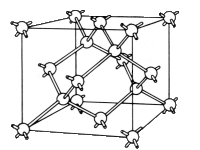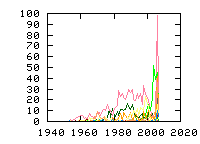« Previous
1
Next »
(19 hits, 1/1)
Showing
10, 25, 50, 100, 500, 1000, all papers per page.
Sort by:
last publication date,
older publication date,
last update date.
- 1. Appl. Phys. Lett. 90, 013104 (2007) , “Scanning tunneling microscopy investigations of hydrogen plasma-induced electron scattering centers on single-walled carbon nanotubes”, G. Buchs, P. Ruffieux, P. Gröning, and O. GröningThe authors report on the generation of localized defects on single-walled carbon nanotubes by means of a hydrogen electron cyclotron resonance plasma. The defects have been investigated using scanning tunneling microscopy (STM) and show an apparent topographic height in the STM of 1–3 ... (Read more)
- 2. Phys. Rev. B 75, 195335 (2007) , “Computational and experimental imaging of Mn defects on GaAs (110) cross-sectional surfaces”, A. Stroppa, X. Duan, M. Peressi, D. Furlanetto, and S. ModestiWe present a combined experimental and computational study of the (110) cross-sectional surface of Mn δ-doped GaAs samples. We focus our study on three different selected Mn defect configurations not previously studied in detail, namely surface interstitial Mn, isolated and in pairs, and... (Read more)
- 3. Phys. Rev. B 75, 085439 (2007) , “Real-space investigation of fast diffusion of hydrogen on Si(001) by a combination of nanosecond laser heating and STM”, C. H. Schwalb, M. Lawrenz, M. Dürr,, and U. HöferThe rearrangement of silicon dangling bonds induced by pulsed laser heating of monohydride-covered Si(001) surfaces has been studied by means of scanning tunneling microscopy (STM). The initial configurations, which were created by laser-induced thermal desorption, consist of isolated pairs of... (Read more)
- 4. Phys. Rev. B 75, 035309 (2007) , “Role of hydrogen in hydrogen-induced layer exfoliation of germanium”, J. M. Zahler, A. Fontcuberta i Morral, M. J. Griggs, Harry A. Atwater, and Y. J. ChabalThe role of hydrogen in the exfoliation of Ge is studied using cross-sectional transmission electron microscopy, atomic force microscopy, and multiple-internal transmission mode Fourier-transform infrared absorption spectroscopy and compared with the mechanism in silicon. A qualitative model for the... (Read more)
- 5. Phys. Rev. Lett. 98, 026802 (2007) , “Microscopic Basis for the Mechanism of Carrier Dynamics in an Operating p-n Junction Examined by Using Light-Modulated Scanning Tunneling Spectroscopy”, Shoji Yoshida, Yuya Kanitani, Ryuji Oshima, Yoshitaka Okada, Osamu Takeuchi, and Hidemi ShigekawaThe doping characteristics and carrier transport in a GaAs p-n junction were visualized with a ~10 nm spatial resolution, using light-modulated scanning tunneling spectroscopy. The dynamics of minority carriers under operating conditions, such as recombination, diffusion, and electric... (Read more)
- 6. Appl. Phys. Lett. 89, 222101 (2006) , “Reversible creation and annihilation of a local leakage path in HfO2/GeOx stacked gate dielectrics: A direct observation by ultrahigh vacuum conducting atomic force microscopy”, K. Yamamura, K. Kita, A. Toriumi, and K. KyunoBy direct observation using ultrahigh vacuum conducting atomic force microscopy, it is found that a local leakage path in HfO2/GeOx stacks created by an electrical stress with a positive tip bias annihilates after applying a reverse tip bias. The creation and... (Read more)
- 7. Appl. Phys. Lett. 89, 143120 (2006) , “Electroluminescence mapping of CuGaSe2 solar cells by atomic force microscopy”, Manuel J. Romero, C.-S. Jiang, J. Abushama, H. R. Moutinho, M. M. Al-Jassim, and R. NoufiThe authors report on the observation of electroluminescence (EL) in CuGaSe2 solar cells using tapping-mode atomic force microscopy based on tuning-fork sensors. Individually injected current pulses are seen during intermittent contact driven by an external bias applied to the conducting... (Read more)
- 8. Appl. Phys. Lett. 88, 212112 (2006) , “Reliability of thermally oxidized SiO2/4H-SiC by conductive atomic force microscopy”, Patrick Fiorenza and Vito RaineriThe dielectric breakdown (BD) kinetics of silicon dioxide (SiO2) thin films thermally grown on 4H-SiC was determined by comparison between I-V measurements on large area (up to 1.96×10–5 cm2) metal-oxide-semiconductor structures and... (Read more)
- 9. J. Appl. Phys. 100, 034911 (2006) , “Thermal evolution of hydrogen related defects in hydrogen implanted Czochralski silicon investigated by Raman spectroscopy and atomic force microscopy”, W. Düngen, R. Job, Y. Ma, Y. L. Huang, T. Mueller, W. R. Fahrner, L. O. Keller, J. T. Horstmann, and H. FiedlerMicro-Raman spectroscopy and atomic force microscopy investigations have been applied on hydrogen implanted p-type Czochralski silicon samples to investigate the hydrogen related defects and their evolution after subsequent annealing. The thermal evolution of interstitial-hydrogen and... (Read more)
- 10. J. Appl. Phys. 100, 023711 (2006) , “Charge trapping properties at silicon nitride/silicon oxide interface studied by variable-temperature electrostatic force microscopy”, S.-D. Tzeng and S. GwoCharge trapping properties of electrons and holes in ultrathin nitride-oxide-silicon (NOS) structures were quantitatively determined by variable-temperature electrostatic force microscopy (EFM). From charge retention characteristics obtained at temperatures between 250 and 370 °C and assuming... (Read more)
- 11. J. Appl. Phys. 99, 113520 (2006) , “Effects of hydrogen bond redistribution on photoluminescence of a-SiC:H films under thermal treatment”, A. V. Vasin, S. P. Kolesnik, A. A. Konchits, V. I. Kushnirenko, V. S. Lysenko, A. N. Nazarov, A. V. Rusavsky, and S. AshokHydrogenated amorphous silicon carbide (a-SiC:H) films have been deposited using magnetron sputtering technique. An integrated investigation of the effect of vacuum annealing temperature on photoluminescence properties and paramagnetic defects and its correlation with structural... (Read more)
- 12. J. Appl. Phys. 99, 023523 (2006) , “Characterization of 6H-SiC surfaces after ion implantation and annealing using positron annihilation spectroscopy and atomic force microscopy”, G. Brauer, W. Anwand, W. Skorupa, S. Brandstetter, and C. TeichertSystematic slow positron implantation spectroscopy (SPIS) and atomic force microscopy studies of various 6H-SiC samples are presented to clarify the role of conductivity type, crystal quality, ion implantation (B+,Al+, and N+), and annealing (1.650 °C) in... (Read more)
- 13. Nature 442, 436 (2006) , “Atom-by-atom substitution of Mn in GaAs and visualization of their hole-mediated interactions”, D. Kitchen, A. Richardella, J. -M. Tang, M. E. Flatt, A. YazdaniThe discovery of ferromagnetism in Mn-doped GaAs1 has ignited interest in the development of semiconductor technologies based on electron spin and has led to several proof-of-concept spintronic devices2, 3, 4. A major hurdle for realistic applications of Ga1-XMnXAs, or other dilute magnetic semiconductors, remains that their ferromagnetic transition temperature is below room temperature. Enhancing ferromagnetism in semiconductors requires us to understand the mechanisms for interaction between magnetic dopants, such as Mn, and identify the circumstances in which ferromagnetic interactions are maximized5. Here we describe an atom-by-atom substitution technique using a scanning tunnelling microscope (STM) and apply it to perform a controlled study at the atomic scale of the interactions between isolated Mn acceptors, which are mediated by holes in GaAs. High-resolution STM measurements are used to visualize the GaAs electronic states that participate in the Mn–Mn interaction and to quantify the interaction strengths as a function of relative position and orientation. Our experimental findings, which can be explained using tight-binding model calculations, reveal a strong dependence of ferromagnetic interaction on crystallographic orientation. This anisotropic interaction can potentially be exploited by growing oriented Ga1-XMnXAs structures to enhance the ferromagnetic transition temperature beyond that achieved in randomly doped samples. (Read more)
- 14. Phys. Rev. B 74, 033304 (2006) , “5-7-5 line defects on As/Si(100): A general stress-relief mechanism for V/IV surfaces”, W. E. McMahon, Iskander G. Batyrev, T. Hannappel, J. M. Olson, and S. B. ZhangAn entire family of nano-scale trenches, ridges, and steps has been observed experimentally on AsH3-exposed Si(100). Some of these line structures have been observed previously, but their structures have remained a mystery. Theoretical modeling shows that they are all based upon the same... (Read more)
- 15. Phys. Rev. Lett. 97, 016102 (2006) , “Scaling and Universality of Roughening in Thermal Oxidation of Si(001)”, Hiroo Omi, Hiroyuki Kageshima, and Masashi UematsuBy analyzing atomic force microscopy images, we derive a continuum equation that quantitatively explains the roughening at the Si(001)-SiO2 interface during thermal oxidation at the temperature at 1200 °C in an Ar atmosphere containing a small fraction of O2. We also show... (Read more)
- 16. Superlatt. Microstruct. 39, 247-256 (2006) , “Optical and morphological features of bulk and homoepitaxial ZnO”, R. Yakimova, G.R. Yazdi, N.T. Son, I. Ivanov, M. Syv?j?rvi, S. Sun, G. Tompa, A. Kuznetsov , B. SvenssonZnO substrate crystals from two different sources, and epitaxial layers have been studied by SEM, AFM, photoluminescence and EPR. Although fabricated by the same growth principle, i.e. the hydrothermal technique, the substrates differ in terms of purity and structural quality. In the PL spectra of... (Read more)
- 17. J. Appl. Phys. 89, 4625-4630 (2001) , “Hexagonal voids and the formation of micropipes during SiC sublimation growth”, Thomas A. Kuhr, Edward K. Sanchez, Marek Skowronski, William M. Vetter, Michael DudleyHexagonal voids observed in sublimation grown SiC boules were examined using optical microscopy, atomic force microscopy (AFM), scanning electron microscopy, KOH etching, and synchrotron white-beam x-ray topography. Voids formed at imperfections in the attachment layer between the seed and crucible... (Read more)
- 18. Phys. Rev. Lett. 86, 1054 (2001) , “Electron Spin Resonance Observation of the Si(111)- (7?7) Surface and Its Oxidation Process”, Takahide Umeda, Masayasu Nishizawa, Tetsuji Yasuda, Junichi Isoya, Satoshi Yamasaki, and Kazunobu TanakaElectron spin resonance (ESR) observation of dangling-bond states on the Si(111)- (7?7) surface is demonstrated for the first time. The ESR spectra clearly show that a reaction of molecular oxygen with the Si(111)- (7?7) surface is associated with the appearance of a new dangling-bond center at... (Read more)Si SiO2| EPR STM/AFM/SPM| Oxygen Pb Ps0 Ps1 Silicon dangling-bond interface surface .inp files: Si/surface(111) | last update: Masatoshi Sasaki
- 19. J. Appl. Phys. 88, 1407 (2000) , “Structural improvement in sublimation epitaxy of 4H–SiC”, M. Syväjärvi, R. Yakimova, H. Jacobsson, and E. JanzénThe sublimation epitaxy growth process has been studied. The structural quality of the grown layers improves compared with the substrate mainly due to a diminished domain structure misorientation. Optical microscopy shows that the as-grown surfaces are free of typical defects appearing in silicon... (Read more)
« Previous
1
Next »
(19 hits, 1/1)
Showing
10, 25, 50, 100, 500, 1000, all papers per page.
Sort by:
last publication date,
older publication date,
last update date.
All papers (3399)
Updated at 2010-07-20 16:50:39
Updated at 2010-07-20 16:50:39
(view as: tree
,
cloud
)
| 1329 | untagged |
Materials
(111 tags)
Others(101 tags)
Technique
(46 tags)
Details
(591 tags)
Bond(35 tags)
Defect(interstitial)(18 tags)
Defect(vacancy)(15 tags)
Defect-type(19 tags)
Element(65 tags)
Energy(8 tags)
Isotope(56 tags)
Label(303 tags)
Sample(17 tags)
Spin(8 tags)
Symmetry(15 tags)

